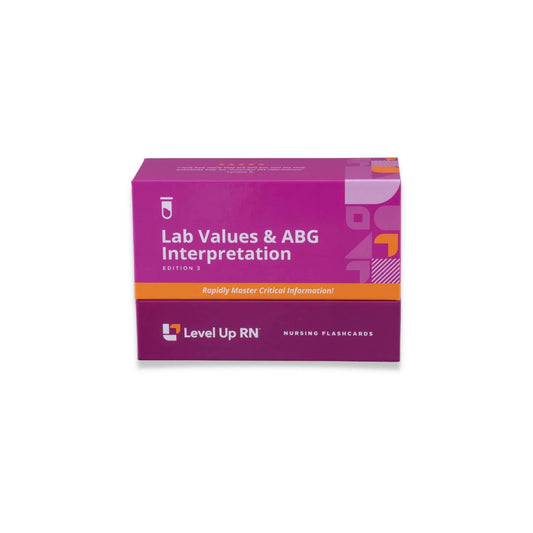In this article, we'll give you an overview of the expected ranges of the most important components in an ABG (pH, PaCO₂, and HCO₃) and we'll explain the three-step process for interpreting ABG results.
Lab Values & ABG Interpretation - Nursing Flashcards
Expected ranges for ABG components
When you are interpreting an ABG result on an exam, the NCLEX, or in your nursing practice, it will be important to know the three key components and the significance of higher or lower values. The three key components in ABG results are pH, PaCO₂, and bicarbonate (HCO₃).
pH
pH on an ABG is a measure of how acidic or basic the blood is, which indicates whether acidosis or alkalosis is present. pH measures hydrogen ion concentration in the blood.
On an ABG, the normal range is between 7.35 and 7.45. pH values under 7.35 indicate acidosis, while pH values over 7.45 indicate alkalosis.
PaCO₂
PaCO₂ on an ABG is the partial pressure of carbon dioxide in the arterial blood, and can be used to represent the respiratory system and its function.
On an ABG, the normal range for PaCO₂ is between 35 and 45 mmHg.
PaCO₂ below 35 mmHg indicates presence of respiratory alkalosis due to hyperventilation OR the respiratory system is compensating for metabolic acidosis.
PaCO₂ above 45 mmHg indicates presence of respiratory acidosis due to hypoventilation, OR the respiratory system is compensating for metabolic alkalosis.
Bicarbonate (HCO₃)
HCO₃, also known as bicarbonate, is an important buffer in the blood, regulated by the kidneys. HCO₃ can be used to represent the metabolic system and its function.
On an ABG, the normal range for HCO₃ is between 22 and 26 mEq/L.
HCO₃ under 22 mEq/L indicates metabolic acidosis, which can be caused by DKA, kidney failure, or diarrhea, OR compensation for respiratory alkalosis.
HCO₃ greater than 26 mEq/L indicates metabolic alkalosis, which can be caused by excess antacids, vomiting, nasogastric suctioning, OR compensation for respiratory acidosis.
What if pH, PaCO₂, and HCO₃ are within the expected range?
If, on an exam, you are given ABG results to interpret where the pH, PaCO₂, and HCO₃ are all within the expected ranges, that means the patient has homeostasis.
The chance of encountering an ABG interpretation problem with all three of these values within the normal range is pretty small. But if you do, that would be good news for that patient!
Three-step process for ABG interpretation
When you are interpreting ABG results, whether in the classroom, on an exam, at clinicals, or in your nursing practice, you can use this three-step process.
Step 1 - Is acidosis or alkalosis present?
Look at the pH. pH values under 7.35 indicate acidosis, while pH values over 7.45 indicate alkalosis. This helps us get narrowed down quickly. You can already do this step right away with what you've learned so far in this series.
Step 2 - Is the respiratory system or metabolic system to blame?
If acidosis or alkalosis is present, you now need to determine which system is to blame. Is it the respiratory system or the metabolic system causing this alkalosis or acidosis?
For example, in the case of acidosis, if PaCO₂ is acidic, then the respiratory system is to blame. But if HCO₃ is acidic, the metabolic system is to blame.
You can learn how to determine this in Videos 4-7 of this series.
Step 3 - Is the system compensating?
Once you have determined whether it's the respiratory system or metabolic system behind the acidosis or alkalosis, you then need to determine if the opposite system is compensating.
If the respiratory system is causing acidosis or alkalosis, is the metabolic system trying to compensate?
If the metabolic system is causing acidosis or alkalosis, is the respiratory system trying to compensate?
And then, if compensation is occurring, you must determine if it's partial compensation or full compensation.
You can learn how to detect compensation in Videos 4-7 of this series.
- ABG Interpretation, part 4: Respiratory Acidosis
- ABG Interpretation, part 5: Respiratory Alkalosis
- ABG Interpretation, part 6: Metabolic Acidosis
- ABG Interpretation, part 7: Metabolic Alkalosis
The ABG Interpretation video tutorial series is intended to help RN and PN nursing students study for nursing school exams, including the ATI, HESI and NCLEX



3 comments
PH-7.54
Pco2-31
Po2-38
Hco3-26.5
Why we don’t talk about Respiratory metabolic?
I would like to know why we do not show how to interpret respiratory metabolic as well ?